| Author | Message | ||
| Jim Rink (Fakeguy)
Registered Member Username: Fakeguy Post Number: 141 Registered: 1-2005 Posted From: 96.11.209.1  Rating: N/A |
I recently pulled a hill in 2nd gear (allison 4-speed)with my 8V71 in my 1962 PD4106. I was towing a landscape trailer with my electric golf cart. On descent of the grade, I left in second gear but the rpms started picking up past the 2000 rpm which is top end for the governor. It got over 2300, so I up shifted to 3rd and used my brakes to steady speed and maintain control. My question is why I was not holding in 2nd gear. It will hold in 3rd on grades not so steep. ( I follow the rule of same gear down as up.) I suspect my engine is losing compression, but am looking for addition analysis and suggestions from other Bus Nuts. Thank you in advance, Jim | ||
| RJ Long (Rjlong)
Registered Member Username: Rjlong Post Number: 1577 Registered: 12-2000 Posted From: 98.192.173.82 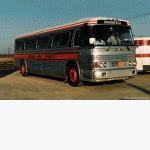 Rating: |
Jim - Four-speed stick is a Spicer. If it was an Allison, it would be a V-730 three-speed. Regardless, depending on the grade, ANY gear might need some assistance from the service brakes to control your downhill speed. Stick or automatic. Weight is obviously a factor, too - adding the trailer & cart this time for example. Me thinks thou should invest in a Jake Brake! FWIW & HTH. . .  | ||
| Don Evans (Doninwa)
Registered Member Username: Doninwa Post Number: 215 Registered: 1-2007 Posted From: 208.81.157.90 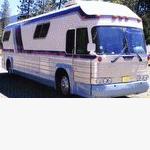 Rating: N/A |
The general rule of going down a hill in the same gear you went up it applies to Jake brake equipped diesels. This assumes that the Jakes give approximately the same 'horse power' equivalent of braking force. In many cases one gear lower works better. Most trucks have more gears to choose from than we do. That and many hills are steeper on one side than the other. In your case you should have either used the brakes to keep the RPMs in the normal range remembering that toward the max RPM usually equates to the most compression braking or shifted DOWN. Shifting up could have put you in a really bad situation. Apparently the hill was not to long and you did not overheat you brakes. There are other forces at work such as more aerodynamic drag at higher speed ect., but the most important thing to remember is to keep the brakes cool enough that you can stop the bus ANYTIME you need to. There has been much debate about either riding the brakes all the way down the hill as opposed to intermittent braking to keep the engine in the desired RPM range. The goal is the same. Keep the brakes cool enough to stop if needed. Keep those brakes cool. Don 4107 | ||
| larry currier (Larryc)
Registered Member Username: Larryc Post Number: 238 Registered: 2-2007 Posted From: 205.188.116.203 Rating: N/A |
Time to adjust the brakes? Diesel engines really don't have compression that amounts to anything as it would apply to brakeing like gas engines have. Kinda like dragging your foot. Probably 3ed gear just picks up enough air to help slow you. The same gear rule will keep you in the range of not out running your brakes most of the time, so I think you are OK there. It did what it was supposed to do, kept you out of trouble. I would stop using the gears in a way that let the engine pick up those kinds of RPM's on a grade, it can suck alot of oil out of the pan as well as scatter alot of parts all over the highway. You can take an engine thats using alot of oil and put a good driver in it and he won't use hardly any oil. He does this by not letting the engine run in a vacuum situation going down hill. The engine will suck oil by the rings and the valve guides on compression/vacuum so a good shoe will keep a little throttle on when brakeing to keep the engine out of the vacuum mode. If you have a runaway condition, holding a gear is not going to make much difference to anything except engine life. A blown engine may not pump air either, so not much to gain and alot to lose. Downhill adventures should all be under brake shoe holding forces unless you have a Jake or Retarder. | ||
| Kyle Brandt (Kyle4501)
Registered Member Username: Kyle4501 Post Number: 488 Registered: 9-2004 Posted From: 65.23.106.193 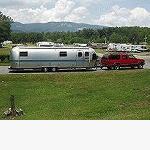 Rating: N/A |
Kinetic energy = mass multiplied by speed squared. Energy increases exponentially with linear increases in speed. Brakes convert kinetic energy into heat. There is a limit to how much heat your brake system can dissipate. Keeping the speed low does 2 things to help keep the brakes from overheating- 1) Less kinetic energy to convert to heat 2) More time to dissipate that heat. | ||
| David Guglielmetti (Daveg)
Registered Member Username: Daveg Post Number: 73 Registered: 2-2009 Posted From: 71.139.244.152  Rating: N/A |
Larry, wow! You have some good points and some weak ones, in my opinion. Anyone else care to comment? I think up-shifting was a mistake in this case. And regarding sucking oil past the rings, which is more important...oil consumption or braking going down hill? Am I reading this correctly? Okay, I'm done. | ||
| John Lacey (Junkman42)
Registered Member Username: Junkman42 Post Number: 87 Registered: 3-2007 Posted From: 69.19.14.28 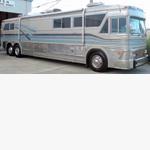 Rating: N/A |
Diesel engines have no throttle plate and therefore have no manifold vacuum! Removing ones foot off the throttle only lets a diesel engine make idle power which in a diesel is considerable. Letting a gas engine breathe creates manifold vacuum and does suck oil past rings and valve stems. John | ||
| John Lacey (Junkman42)
Registered Member Username: Junkman42 Post Number: 88 Registered: 3-2007 Posted From: 69.19.14.28  Rating: N/A |
Diesel engines have no throttle plate and therefore have no manifold vacuum! Removing ones foot off the throttle only lets a diesel engine make idle power which in a diesel is considerable. Letting a gas engine breathe creates manifold vacuum and does suck oil past rings and valve stems. John | ||
| john w. roan (Chessie4905)
Registered Member Username: Chessie4905 Post Number: 1539 Registered: 10-2003 Posted From: 71.58.110.9 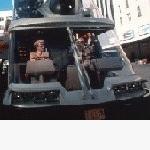 Rating: N/A |
Don't worry about sucking oil past the rings on down hill. As John L says, there is no throttle plate closing in our diesels, creating a vacuum in the intake port and manifold area, as happens on gasoline engines.That is what it takes to pull oil past piston rings. You will still have manifold PRESSURE as the blower is always turning, making pressure or boost. You will have idle fuel going into the combustion chambers though. Make sure you don't have your idle speed set too high; some raise it some to keep the oil pressure at idle from being too low. These engines have alarmingly low oil pressure at idle, but it doesn't hurt them, as long as running pressure is satisfactory. That oil pump circulates the oil to quite a great deal of passages. You should have stayed in second, especially with a trailer behind. Apply the brakes to bring it from your 2000 rpm down to , say 13 or 14 hundred rpm, then let it build back up to 2 thousand, and repeat. What if you couldn't get it into 3rd when you tried to upshift( if it was a standard trans.) and stuck in neutral. A long hill and you might run out of brakes. This can especially be scary if one of your drums is coated with oil from a leaking seal. If you plan on hauling a trailer regularly, you should consider getting Jake brakes installed on your engine. You may get into going down a much longer, steeper grade than you realized some day and find your brakes aren't up to the task. | ||
| Don Evans (Doninwa)
Registered Member Username: Doninwa Post Number: 216 Registered: 1-2007 Posted From: 208.81.157.90  Rating: N/A |
"You can take an engine thats using alot of oil and put a good driver in it and he won't use hardly any oil. He does this by not letting the engine run in a vacuum situation going down hill. The engine will suck oil by the rings and the valve guides on compression/vacuum so a good shoe will keep a little throttle on when brakeing to keep the engine out of the vacuum mode." Are You suggesting using throttle while going down grade???? How can you create vacuum in a diesel when the intake is wide open on most diesels. Two cycles specifically have forced induction to fill the cylinder regardless of where the throttle is. Remember that throttle on most diesels is the amount of fuel injected, not the amount of air being pumped through the mill. "Downhill adventures should all be under brake shoe holding forces unless you have a Jake or Retarder." While I would never seriously suggest it, if you think a diesel does not exhibit good compression braking, compare the braking force required to go down a steep long grade in gear and out. Again, I am not suggesting anyone try this, just think about the consequences. I stand by my suggestion that the original poster should have used brakes to keep the RPMs under redline and or shifted DOWN not UP in his situation. Lets be careful out there, Don 4107 | ||
| Tony LEE (T_lee)
Registered Member Username: T_lee Post Number: 63 Registered: 11-2007 Posted From: 59.154.2.62 Rating: N/A |
"if you think a diesel does not exhibit good compression braking," I understood that any so-called compression braking from a diesel comes about more from drive-train and engine friction. | ||
| Jim Rink (Fakeguy)
Registered Member Username: Fakeguy Post Number: 142 Registered: 1-2005 Posted From: 96.11.209.1  Rating: N/A |
oops, my error...is in fact a spicer tranny...was not thinking at the time Thanks to all for the input | ||
| Bill Gerrie (Bill_gerrie)
Registered Member Username: Bill_gerrie Post Number: 277 Registered: 3-2006 Posted From: 216.198.139.38 Rating: N/A |
Reading this post shows the advantage of a Jake Brake on a diesel. If anyone is interested in Jake Brakes I have one set for an 8 cylinder available. Check my profile to contact me. Ian. I tried to post in the classified but I can't remember my login info. Bill | ||
| marvin pack (Gomer)
Registered Member Username: Gomer Post Number: 537 Registered: 3-2007 Posted From: 71.53.155.14 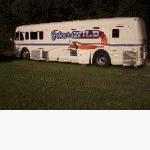 Rating: N/A |
Oops Senior moment? Duals on an 04 makes people wonder whatsuuppp!! I have a set on mine and the gen set is there and a lot a questions are ask. LOOKS GOOD THO!! gomer | ||
| marvin pack (Gomer)
Registered Member Username: Gomer Post Number: 538 Registered: 3-2007 Posted From: 71.53.155.14  Rating: N/A |
OOPS wrong thread!! Senior Moment, DUH gomer | ||
| David Guglielmetti (Daveg)
Registered Member Username: Daveg Post Number: 74 Registered: 2-2009 Posted From: 70.140.219.12  Rating: N/A |
John Junkman-thanks John Junkman-thanks John Roan-exactly right...thanks. | ||
| Gus Causbie (Gusc)
Registered Member Username: Gusc Post Number: 938 Registered: 11-2005 Posted From: 208.54.200.78 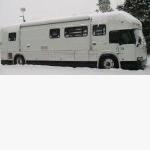 Rating: N/A |
A diesel engine brakes because it acts as an air compressor when there is no fuel for combustion. You overran your gov because the gov only controls fuel, not rpm alone. Anyone who thinks diesels don't provide braking needs to ride in any bus with a manual trans to find out the facts. My 4104 with 4sp Spicer holds back great in the Rockies and all other mnts around the country I have been in both east and west. I heard all these stories about diesels, especially two strokes, not providing engine braking downhill so I was thinking about installing a Jake. Found out I don't need one. On four lanes I never use lower gears, don't need them. The whole secret is to start downhill at a slow speed and you won't need to shift down. If you try to shift down and miss after the bus gets too fast you are in for a wild ride. (Message edited by gusc on June 25, 2009) | ||
| George M. Todd (George_mc6)
Registered Member Username: George_mc6 Post Number: 891 Registered: 8-2006 Posted From: 76.171.79.185 Rating: N/A |
Gus, Unfortunately you are describing a diesel engine with Jake Brake in operation. Without Jake, the pressure built up when the piston is pushed up by the crank pushes the piston down on what would be the power stroke. The reason you feel retarding effort while in gear is the drag caused by the fan, alternator, air compressor, water pump, oil pump, and the friction of rings and bearings. The comment about diesels not providing as much braking as a comparably sized gas engine is correct. Never let a hill turn the engine above max governed rpm, as in the scattered parts comment, once that happens, no air compressor either. Actually, there is NO fuel injected when the engine is being turned by the driveline at above idle speed, thats how the Jake buffer switch knows how to turn the Jakes on, (the gov moves the rack into the no fuel position.) G | ||
| Mel La Plante (Mel_4104)
Registered Member Username: Mel_4104 Post Number: 125 Registered: 7-2006 Posted From: 99.199.171.162 Rating: N/A |
i always remember a fellow that had a logging company and when he went to hire a ne driver he would sit in the passanger seat and let him take the truck up the hill with only the trailer on the truck. if the guys driving did not suit Ed he would have the truck loaded and get behind the wheel himself and the guy new he did not get the job. the point is that if you do not know how to handle a unit on hills you should not drive it. oh yes we call the mountains hills when you talk to the other drivers. so take in the fact that we are refering to a bus that is near full weight as designed by GM then hooked a trailer loaded on behind with a 2 stroke engine , a 4 speed square cut tranny with no syn. mesh gears, wanting to go over the top of the hill at high TPM even in a low gear range adds up to a lot of pictures of the crash site. so forget the big hurry to get to the bottom , time is not the main thing your life is so slow at the top and NO high RPM going down and you be able to enjoy the next day. | ||
| Don Evans (Doninwa)
Registered Member Username: Doninwa Post Number: 217 Registered: 1-2007 Posted From: 208.81.157.90  Rating: N/A |
"Unfortunately you are describing a diesel engine with Jake Brake in operation. Without Jake, the pressure built up when the piston is pushed up by the crank pushes the piston down on what would be the power stroke. The reason you feel retarding effort while in gear is the drag caused by the fan, alternator, air compressor, water pump, oil pump, and the friction of rings and bearings. The comment about diesels not providing as much braking as a comparably sized gas engine is correct." We have had this discussion before. The compression (energy) of a diesel is converted to heat and carried away by the cooling system. The argument that a gas engine has more compression braking because of the vacuum on the intake stroke ignores that the same vacuum is sucking up on the piston during the compression stoke. I have a gas bus with a 478 engine and it has less compression braking than the 4107 with what, 568 cubes. I have had identical vehicles powered by gas and diesel and the diesels always have more compression braking. Before you tell me the gearing was different, my son and I removed a 6.2 diesel from a pickup and installed a gas 454 with the same tranny, torque converter, and gears and has noticeably less compression braking with the BIGGER gas engine. Much more satisfying when you push on the go petal.  It's easy to prove to yourself. Go to your local Dodge dealer and test drive a 5.9 diesel and a 5.9 (360) gas pickup with standard trannies. Don 4107 | ||
| marvin pack (Gomer)
Registered Member Username: Gomer Post Number: 542 Registered: 3-2007 Posted From: 71.53.155.14  Rating: N/A |
Ya wanna learn how to drive a bus/truck over da HILLS?? Go to Harrisonburg VA, turn on rt 33, east or west don't make no difference, when ya get to da bottom of one, you will start up the other,and then when you turn around to go back, it is just reversed. Uphill both ways LOL. Believe me you will learn quick because your life is in your hands up and down both sides. Now when you get it all figured out,try it again. It will be different again... Gomer | ||
| larry currier (Larryc)
Registered Member Username: Larryc Post Number: 239 Registered: 2-2007 Posted From: 205.188.116.203 Rating: N/A |
David, "Whats more important, oil consumption or braking going down hill"? I think the issue at the end of the day is all the equiptment comes home to the bus or truck yard. No one parked it on the escape ramps or ran out of brakes on the grade if they were any kind of driver at all. If you pull the dipstick on say unit 121 on Friday and Dave drove it and it is 2 gallons down and you pull Larry's dipstick on 118 and its a quart down, you can put those drivers in the other units for the next run. If the oil use follows the driver then a good manager should go for a ride with both drivers and find out what the secret is to low oil consumption. Thats not hard to do if you runout of Lewiston Id. and you have over a hundred units running the (old) Lewiston Grade everyday to supply the Mill. I learned first time out of the yard, (1960s), that there is really no compression to speak of involved when it comes to heavy equiptment. Its like dragging your foot if you have any weight involved at all. This really brings us to proper braking and leaving the engine out of the senario. Thats why they call them service brakes. Proper braking will always get you down the mountain safely if you have maintained your brakes. Hoping for the engine to somehow save or assist you without a retarder or a Jake is just an accident waiting to happen. Thats where Jim was when he over ran the governor in 2nd gear. If he didn't shift up, parts would eventually scatter, and I'll bet that you could put the oil left in the pan in a milk jug when it rolled to a stop! The oil consumption thing is a professional driver trick that you learn from the big fleets and the old timers. I have done my 40 years both in the fleet shop and over the road so all I can relate is what 40 years has taught me. Yes, I use throttle and brakes going down hill. I also do that right after I go over the top to keep the engine from cooling real fast. Helps keep those engines alive longer. Don, once you over run the governor in 2nd gear you cannot put the transmission into first gear. These are non syncro transmissions and while thats a great idea if the engine could take the RPM, there is no way to get there. The engine is sort of for going up the hills and the brakes are sort of for going down the hills! John, If you are running with your brake drums coated with oil, then you should be out of service an not out on the mountain, under any circumstances. We are discussing over speeding an engine, because the driver becomes scared of the grade and is losing control in his mind. From experience, there are not to many grades in this country that I have not conquered in Mexican overdrive one time or another, so never panic, you can likely roll of the bottom no problem anyway! Don, I'm in your neighborhood, lets take those 2 pickups, put 10,000lbs in the back of both of them and roll them off East Bound Vantage and find out. There is probably not a lot of corelation between pickups and trucks and buses. but I like your example! Personally, I would never start up a mountain pass with bad brakes, bad wheel seals,or anything else that would force me to rely on anything else whatsoever than my service brakes. Service brakes have moved people and freight safely for many years even without retarders and Jakobs brakes. Proper use and maintence of service brakes are still to this day, all that is needed to safely take you and your bus anywhere you want to go. All you really need the engine to do going down hill is to supply a steady source of AIR. In the event the engine fails to do that for you then the emergency brakes will likely bring you to a stop, since thats what they were designed to do. | ||
| Gus Causbie (Gusc)
Registered Member Username: Gusc Post Number: 942 Registered: 11-2005 Posted From: 208.54.200.49  Rating: N/A |
George, I didn't say a diesel has more compression braking than a gas engine but I don't think it has any less. I don't really know for sure and the theory is not important, the fact that my 4104 has excellent engine compression resistance downhill is what is important. I've crossed the Cascades, the Appalachians, the Coast range, the Olympics and the Rockies ten times both north and south and the amount of downhill retarding is significant. There is no way I buy the theory that this is all caused by mechanical friction and alternator load!! You may be ignoring the fact that the diesel compression is much, much higher than the gas. The intake stroke of a gas engine fills the cyl with air. When the intake valve closes this air is compressed on the compression stroke, there is no vacumn. Vacumn is caused by the throttle plate restriction and is in the throttle throat, not the cyl. In the case of the DD two stroke the air is blown in as I'm sure you know. | ||
| David Guglielmetti (Daveg)
Registered Member Username: Daveg Post Number: 75 Registered: 2-2009 Posted From: 71.139.244.152  Rating: N/A |
Yeah, this is what I mean! Tell us what you think! | ||
| Gus Causbie (Gusc)
Registered Member Username: Gusc Post Number: 943 Registered: 11-2005 Posted From: 208.54.200.49  Rating: N/A |
David, Your posts are very informative!! | ||
| Skip N (Skip)
Registered Member Username: Skip Post Number: 56 Registered: 11-2006 Posted From: 161.7.77.247 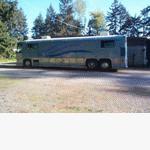 Rating: N/A |
I think there is an oversight and it has nothing to do with diesel vs. gas engines on using an engine to slow a rig down. Both of them have problems with holding once the rpm's get above a certian point. Being the diesel has a smaller rpm swing it is noticed as ineffective quicker. YOMV This opinion may be based on personal observation. I have had both gas and diesel become ineffective after a certain rpm and only running 30k#. Bottom line use both and be careful. Slow down and save your shorts for another day  Oh and one should talk to the house owner at the end of the run out in Lewiston Id.....Truck ended up in the persons house. Friend hauling fert saw the damage on that one  Skip | ||
| Tony LEE (T_lee)
Registered Member Username: T_lee Post Number: 64 Registered: 11-2007 Posted From: 59.154.2.62 Rating: N/A |
"You may be ignoring the fact that the diesel compression is much, much higher than the gas." The cylinder of a diesel during compression and power stroke is little difference to jumping up and down on a pogo stick. Energy is largely conserved. The energy required to move the piston up to compress the gas is largely recovered when the compressed gas pushes down on the piston during the power stroke. Cranking a single cylinder engine by hand may seem as if there is a lot of braking on the compression stroke - and it may stop you dead, but with a multiple cylinder engine, once it is turning, there is little nett retardation from the compression effect. What there is is due to the heat generated by compressing the gas leaking away at the top of the stoke so reducing the energy available to push the piston back down. A gas engine is sucking the air in through a restriction and blowing it out through no restriction so in effect is similar to a diesel engine fitted with an exhaust brake (butterfly valve somewhere in the exhaust pipe) "The intake stroke of a gas engine fills the cyl with air. When the intake valve closes this air is compressed on the compression stroke, there is no vacumn. Vacumn is caused by the throttle plate restriction and is in the throttle throat, not the cyl. In the case of the DD two stroke the air is blown in as I'm sure you know." I guess the difference is similar to a patient struggling to breath because of badly restricted airway (a gas engine) and being positively blown with a respirator (as is a DD). One way requires an effort, the other needs no effort. Effort is equivalent to braking. | ||
| john w. roan (Chessie4905)
Registered Member Username: Chessie4905 Post Number: 1541 Registered: 10-2003 Posted From: 71.58.110.9  Rating: N/A |
The vacuum in the intake manifold because of the throttle plates closed also acts on the piston when the valve opens. no air is going into the cylinder since it is drawing on that vacuum. Since it then comes up and compresses what little air that may be in the cylinder and the plug fires with no fuel or little, there is no significant amount of power stroke. So there is a good amount of hold back. Plus, the turbo is not creating boost, and can also contribute to hold back from interference of the airflow. You can't compare the Cummins truck diesel with the 360. Although there is no vacuum or little, there is drag on the pistons and those heavy piston rings that also act on the 4 1/2" stroke of the crankshaft, taking advantage of that leverage. The 360 has, I believe, a 3 1/2 inch stroke... less leverage. also, the new gas engines use low drag piston rings, cutoff of fuel on coast down, and exhaust egr into cylinders. Another thing about a Detroit 2 cycle; with all those rings on the piston, there is quite a bit of drag on it early on it it's rebuild life, hence the better hold back. A well worn version will have a LOT less hold back, but will out run a comparable engine that is next to a pretty new rebuild. Old truckers will tell you that their 318 ran the best it ever did right before it blew. Although " blew" was just an expression. Usually a top ring area of the piston would deteriorate or a head to liner seal would fail, cracked head etc., consuming great amounts of oil in use or lots of white or blue smoke. Also, the gearing in that 4106 is different than his 04, probably the difference of a gear, AND he was pulling a trailer or should I say that the trailer was pushing the coach. | ||
| Jim Rink (Fakeguy)
Registered Member Username: Fakeguy Post Number: 143 Registered: 1-2005 Posted From: 96.11.209.1  Rating: N/A |
Mel. Thanks for the interesting story about the logging truck. I have never driven a logging truck or been a professional bus driver. I have only driven cab over Kenworth with 13 speed spicer and 318 Detroit (8V71) grossing 73,000 lbs hauling beer throughout Indiana, Illinois and Wisconsin, driven single and twin screw Macks, Freightliners and Transtars with 10 speed road rangers and single axle Internationals with 10 split axle. I also have hauled steel out of Gary Indiana, peddle freight throughout Chicago to include Straight Truck in the Loop, piggy back rail trailers in and out of the Chicago railyards. However, none of that experience would qualify me as an experienced bus driver and thus my question about the picking up rpms on downgrade. Most of my experience has been on fairly flat terrain. My trailer on with my golfcart behind my bus, is different from a 45 ft flatbed with 40,000 lbs of steel slabs on it which I have hauled in the past,so I admit to lack of experience there as well. Thanks to you and all the other responders to have provide a bunch of helpful info. | ||
| Tom Christman (Tchristman)
Registered Member Username: Tchristman Post Number: 102 Registered: 1-2006 Posted From: 66.218.33.156 Rating: N/A |
Easy- when you shifted up, you increased speed, increased wind resistance that held you back. Get a Jake brake installed-I have one with my V730 and it works great. Course, Don Fairchild sets it up and is tighter then most adjust it. I can hold speed going down the north bound I-5 Grapevine which is 5 miles of 6% grade without touching my brakes. Good Luck, TomC | ||
| Bill Gerrie (Bill_gerrie)
Registered Member Username: Bill_gerrie Post Number: 279 Registered: 3-2006 Posted From: 216.198.139.38 Rating: N/A |
Tom Can you be more specific as to what Don Fairchild does to make the Jake work better. They have very limited adjustments on them so I am curious as to what he does. Always looking for improvements. Thanks. Bill | ||
| John MC9 (John_mc9)
Registered Member Username: John_mc9 Post Number: 934 Registered: 7-2006 Posted From: 74.235.211.25 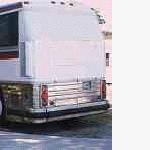 Rating: N/A |
Jim - Don Evans and Gus (and a few others) are right on the money. Using the same gear down, as you used to go up, has always been the rule. The brakes will still have to be used to hold the speed down to keep from over-running the governor. But never try to shift if you're exceeding the governor. If you miss, you're going to be in for one helluva ride. Use the brakes to bring it back into control. If it's that steep of a grade... stop... and use a lower gear for the trip down. Never shift up if you're trying to slow down.... The rig already wants to go faster; why help it kill you, if you want to go slower? I said this once before: Anyone that thinks the diesel bus does not have enough compression to slow it down, should coast at 15 miles per hour with the clutch in and in first gear.... and pop the clutch out. Let me know how far your head goes through the windshield. Good grief. Buses rarely, if ever, had Jake Brakes. The noise would annoy everyone along the routes, including the passengers. Yet, we cruised the mountains and valleys without a problem, and never a complaint... and even rarer..... an accident. Go figger? | ||
| George M. Todd (George_mc6)
Registered Member Username: George_mc6 Post Number: 895 Registered: 8-2006 Posted From: 76.171.79.185 Rating: N/A |
Gus, You have to think about a gas engine being turned by the driveline, with the throttle closed. The intake manifold is under vacuum from the other pistons being pulled down by the crank, with the intake valves open on the intake strokes, and the carburetor butterfly valve closed. So, when a piston is at the top of the intake stroke, and the intake valve opens, the cylinder is exposed to a vacuum, and as the piston is pulled down, it creates more vacuum. Does this vacuum start to pull the piston up? Yes, but much more effort is consumed pulling the piston down against a vacuum from the top, and remember the intake valve closes at the bottom of the stroke. On the compression stroke, the cylinder goes from a vacuum to a low pressure part way up, and yes, that pressure starts to push the piston down on the power stroke. There is a little vacuum created at the bottom of the power stroke, which is broken when the exhaust valve opens. Essentially nothing is exhausted, because nothing was taken in on the intake stroke... Bottom line is that a gas engine creates more braking than a 4 cycle diesel of the same displacement. It doesn't matter what the compression ratio of a non-Jake diesel is, because the higher air pressure will just push the piston back down harder on the power stroke,. Compression braking by heat removal? In THIS thread is somebody saying he "...uses throttle and brakes to keep the engine from cooling off too fast when going downhill..." Although I don't personally agree with that at all, I'm just using it to make my point about how little heat transfer occurs, because the temp gauge does go down quickly when the throttle is released, which means not much heat is being taken out of the compressed air? Think also about the amount of time the compressed (hot) air is exposed to the top part of the cylinder walls, the top of the piston, and the head? Hint: 1800 RPM = 30 strokes per SECOND, and less than half of that time, or 1/60 of a second, times 30 in a 2-Cycle, is the cylinder air temp greater than the block, so heat transfer can occur. Dump the clutch in low gear at 15 mph in a gas engine and it will do the same thing, you still have to accelerate a bunch of HEAVY stuff, a crank and pistons, cams, a flywheel, a big fan, an air compressor, an alternator, probably a steering pump, etc. This is a comparison between apples and oranges, with the end result being a yellow citrus fruit! G | ||
| Jim Rink (Fakeguy)
Registered Member Username: Fakeguy Post Number: 144 Registered: 1-2005 Posted From: 96.11.209.1  Rating: N/A |
Hey...thanks a lot to all for the great info. John MC9 see my error in upshifting...guess I was just over confident in my ability to hit 3rd, but will not risk again. The grade was not all that steep and I had my rig under control the whole time. I was really checking to see how well 2nd would hold on this grade having been over this hill a few times before. I have gone up and down in third before, using the service brakes to manage speed on the way down. Nuff said by me. All the feed back has given me a greater understanding of handling grades with a 4 speed which I never had driven until I got my bus. Lots of other engines and tranny combos but never a 318 and 4 speed. Thanks again to all. | ||
| Don Evans (Doninwa)
Registered Member Username: Doninwa Post Number: 218 Registered: 1-2007 Posted From: 208.81.157.90  Rating: N/A |
George you can repeat your theory all you want. I have given you examples of comparable sized gas and diesel engines that show in the real world that it just ain't so. If you insist on talking theory only, here is mine. The fact that a diesel cools down when running against compression increases the ability to absorb more heat from the compression stroke due to the head/cylinder being cooler increasing the difference of head temp to compression heat. Result, good heat transfer. If this heat transfer does not happen, why is it that you can sometimes start a cold diesel by cranking a while which warms the cylinder/head enough to start? Why did old diesels use pony engines to turn the engine to heat the combustion chamber enough to start/run? If your theory of diesel engines returning most of the energy from the compression stoke to the crank is true, measure the amperage of the starter when turning the engine with the injectors removed (no or little compression) and compare that with cranking the engine in a no fuel situation with normal compression. If your theory stands there should be no or little difference in the effort (amperage) to turn the engine. I would be thrilled if my diesels turned over as easily to start as if they had no compression. I much prefer going down hill in my diesel bus of about the same weight as my gas bus. I'll smile even more when it has jakes. YMMV Don 4107 (Message edited by Doninwa on June 29, 2009) | ||
| ED Hackenbruch (Shadowman)
Registered Member Username: Shadowman Post Number: 127 Registered: 11-2003 Posted From: 70.192.201.193 Rating: N/A |
Ah yes, pony motors.....that brings back a few memories. And triggers another one too. It seems to me that we had an old NorthWest Crane that had a 4-71 or a 6-71 detroit in it. Pretty sure it was the 6, anyway it had a lever that you pushed or pulled which released the compression while you spun the engine a few times to warm it up a little and then you released the lever and spun it again to get it to fire up. Anybody else ever do this? Did they ever have this on buses? | ||
| George M. Todd (George_mc6)
Registered Member Username: George_mc6 Post Number: 896 Registered: 8-2006 Posted From: 76.171.79.185 Rating: N/A |
Don, You mention a 478 Cubic Inch 4 cycle gas engine, and a 568 2 cycle diesel engine. You turn the 478 gas engine two complete revolutions, and you have compressed 478 cubic inches. Turn the 8V71 Detroit over twice, and you have compressed 1,136 cubic inches. Secondly, the engine cools down going downhill because of the lack of heat being taken out of the compressed air, if there was all sorts of heat coming out of it, the engine wouldn't cool off... Does a cooler cylinder head allow for more heat transfer? Absolutely! One last question. 1800 RPM is 30 turns per second, how fast does the stater turn the engine over? (Nowhere near that fast.) Cranking a cold engine until it starts? How does that work if compression heat is carried away by the cooling system? (It seems to me that for that to work, which it does, the heat can't travel away from the surface of the head and the piston? I made the switch from gas to diesel in a pickup truck, putting a 6BT Cummins in a 75 Dodge Power Wagon. This required changing the axle ratios from 4:11 to 3:56, installing a much larger torque converter, and adding a Gear vendors overdrive. 440 CI gas engine removed, 360 diesel installed. Comparing before and after is just like trying to compare your two buses, you can't, because they are apples and oranges, and a comparison produces lemonade. The truck goes much better uphill now than it did before, the bigger torque converter does a much better job of turning the engine nearer driveline speed, and going downhill requires more braking than it did before. The old Cat Dozer diesels had a pony engine because they didn't have an electrical system at all. You started the gas pony with a rope, and the pony exhaust went into the diesel intake manifold to warm it. Then you engaged the pony to start the main engine. One more thing is to look at the Jake Brake ads touting "...keeps the temperature up while going downhill..." G | ||
| Don Evans (Doninwa)
Registered Member Username: Doninwa Post Number: 219 Registered: 1-2007 Posted From: 208.81.157.90  Rating: N/A |
"You mention a 478 Cubic Inch 4 cycle gas engine, and a 568 2 cycle diesel engine. You turn the 478 gas engine two complete revolutions, and you have compressed 478 cubic inches. Turn the 8V71 Detroit over twice, and you have compressed 1,136 cubic inches." What RPM does the gas engine turn compared to the DD? Not quite twice but close. "Secondly, the engine cools down going downhill because of the lack of heat being taken out of the compressed air, if there was all sorts of heat coming out of it, the engine wouldn't cool off... Does a cooler cylinder head allow for more heat transfer? Absolutely!" Because of lack of heat being taken out of compressed air? How about it cools down because there is little or no diesel being burned to generate heat and the intake is wide open pumping cool air through the engine just like a giant compressor which it you ever notice the heads get hot on compressors. If compression does not create heat that needs to be carried away why is the air compressor head on your bus water cooled? "Cranking a cold engine until it starts? How does that work if compression heat is carried away by the cooling system? (It seems to me that for that to work, which it does, the heat can't travel away from the surface of the head and the piston?" It works because it warms up the cylinder/head which was very efficiently adsorbing to much of the heat from compression to fire. If diesel engines return most of the energy of compression to the crank why do diesels need heavy duty starting systems? Even in comparable sizes they many times require two batteries. "Comparing before and after is just like trying to compare your two buses, you can't, because they are apples and oranges, and a comparison produces lemonade." "I made the switch from gas to diesel in a pickup truck, putting a 6BT Cummins in a 75 Dodge Power Wagon. This required changing the axle ratios from 4:11 to 3:56, installing a much larger torque converter, and adding a Gear vendors overdrive. 440 CI gas engine removed, 360 diesel installed." Talk about apples to oranges. Changed the bigger engines for a smaller diesel, changed the rear gear, changed the torque converter, added overdrive and it is a direct comparison? If you are going to compare Dodge rigs you need to stick to standard tannies. Dodge has notoriously loose torque converters. Some of their diesels let the engine drop to idle when you back off. My buses? Two factory original standard transmission rigs that are about the same weight and close in cubes is apples and oranges? Nothing like discussing something with someone that is just as hard headed as I am.  Don 4107 that holds back. GMC 478 that wishes it could. | ||
| David Evans (Dmd)
Registered Member Username: Dmd Post Number: 340 Registered: 10-2004 Posted From: 173.68.141.145 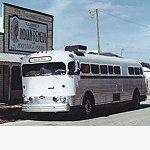 Rating: N/A |
Back when i drove a low-boy for John Deere, i picked up a old D7 cat with a cable blade and it had a gas pony motor that you started and then threw the lever to engage the diesel and away she went. (i dident even try to bluff when the guy asked if i knew how to start it) Dori's cousin in Michigan has a tractor that starts on gas and then changes over to diesel. Pretty cool. And just to add more to the thread, my operators manual (1948)has a paragraph titled " using engine as brake" it says"the GM series 71 diesel engine is a very effective brake in checking vehicle speed when decending gradesl Braking effect of engine increases with its speed. The maximum speed, however, must not exceed 2000 rpm. Engine running at goverened speed, will safely hold vehicle desecending a grade in the same gear as it is required to climb the same grade.When descending grades with the accelerator in the released position, governor will automatically shut off fuel supply to injectors, which allows engine to attain mazimum braking effort at all speeds above idle up to 2000 rpm." I still like the jake brake. | ||
| John MC9 (John_mc9)
Registered Member Username: John_mc9 Post Number: 942 Registered: 7-2006 Posted From: 74.162.65.89  Rating: N/A |
Excellent Dave! Absofrikkinlutely excellent! Some of us old veteran bus drivers manage to get a kick out of the engineering explanations of "why it can't be so". Some of us lived through the "why it is so" episodes, and remember them as if it was yesteryear. HAR de HAR HAR Oh well. | ||
| john w. roan (Chessie4905)
Registered Member Username: Chessie4905 Post Number: 1553 Registered: 10-2003 Posted From: 71.58.110.9  Rating: N/A |
How do you know what gear the grade required to climb it if you never climbed it, but are just going down an unfamiliar one.Maybe some of those 04's hold back so much because the gasoline air conditioning engine is still in place and still operating. Maybe that can be kicked in on downgrades! Another thing to muddy up the waters; those gas engines back in the 40's only had 5 to7 to 1 compression ratio. | ||
| Buswarrior (Buswarrior)
Registered Member Username: Buswarrior Post Number: 1647 Registered: 12-2000 Posted From: 76.71.101.148 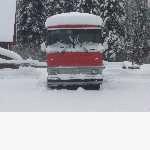 Rating: N/A |
Thank you John. As you noticed, the advice is only good as a summary of experience for those who have already done it, and absolutely useless as a training concept to someone who hasn't. If we trained doctors or pilots like we train drivers.... happy coaching! buswarrior | ||
| George M. Todd (George_mc6)
Registered Member Username: George_mc6 Post Number: 898 Registered: 8-2006 Posted From: 64.55.111.6 Rating: N/A |
Well Don, You're right, being hard headed saves one from being injured when falling head first off a turnip truck! Unfortunately it doesn't help others from breaking their fingers when posting before thinking! As I said above, a 478 Cubic Inch 4 cycle gas engine HAS TO TURN TWO COMPLETE REVOLUTIONS TO COMPRESS 478 CUBIC INCHES! Also, that turning an 8V71 over once will compress 568 Cubic inches, right? So, if we stop and THINK about this for a minute, the 478 Gasser with a 6:56 differential will compress 478 inches, while the 8V71 with a 3:78 ratio will compress 568 Cubic inches per turn of the rear wheels... That's 90 cubic inches less for the gas engine, per revolution of the rear wheels, before we even think of the fact that the gas bus didn't have a 6:56 diff, it was probably in the high fours! Then there is a long thread on shutters, and their purpose and operation, about three weeks ago. One post says the purpose of shutters is to keep the engine from cooling off too quickly, because it could break the crank from cooling off too soon after cresting a hill, and nobody disagreed with it. Many people also posted that they had removed their shutters, and didn't have adverse effects on anything but heater performance. My point here is again that the engine cools off rapidly when the throttle is closed, while going downhill. I personally don't have a problem with my engine dropping from 200 to 180 over a couple of minutes, and I have no idea how old the V12 is, or how many hundreds of thousands of miles are on it. Shutters are long gone, and the fan WAS wired to operate continuously. Down any length of hill, the temp gauge drops to 180, the thermostats close, and the fan stops, which to me means that not a LOT of heat is removed. I never said that a diesel doesn't make ANY compression braking, I said it makes LESS than a comparably sized gas engine, and along with Tony and John R, I stick with it. Next question is to those who feel that a diesel has more compression braking just because it has a higher compression ratio than a gas engine. Turbocharged Detroits (and others) have a compression ratio about 3 points lower than a naturally aspirated engine. So, why isn't there a big difference in compression braking between a 6V92T and an 8V71N? Good grief, and go figger! Regards, Hard-headed George | ||
| Len Silva (Lsilva)
Registered Member Username: Lsilva Post Number: 266 Registered: 12-2000 Posted From: 24.164.20.23  Rating: N/A |
QUOTE...Hey...thanks a lot to all for the great info. John MC9 see my error in upshifting...guess I was just over confident in my ability to hit 3rd, but will not risk again. The grade was not all that steep and I had my rig under control the whole time. I was really checking to see how well 2nd would hold on this grade having been over this hill a few times before. I have gone up and down in third before, using the service brakes to manage speed on the way down. Nuff said by me. All the feed back has given me a greater understanding of handling grades with a 4 speed which I never had driven until I got my bus. Lots of other engines and tranny combos but never a 318 and 4 speed. Thanks again to all.... UNQUOTE Jim, If you able to go up and down in third gear, it barely qualifies as a hill. Len | ||
| Jim Rink (Fakeguy)
Registered Member Username: Fakeguy Post Number: 145 Registered: 1-2005 Posted From: 96.11.209.1  Rating: N/A |
Len. Thank you for the quote and input | ||
| George M. Todd (George_mc6)
Registered Member Username: George_mc6 Post Number: 899 Registered: 8-2006 Posted From: 76.171.79.185 Rating: N/A |
Hey, I blew it, don't know what I wasn't thinking, I knew what I meant, but it wasn't what I said! Should have been one turn of the wheels on an 8V71 with a 3.78:1 diff will compress about 2000 cubic inches. One turn of a 478 Gasser's wheels with a 5.00:1 diff would compress a little less than 1200 cubes. G? |